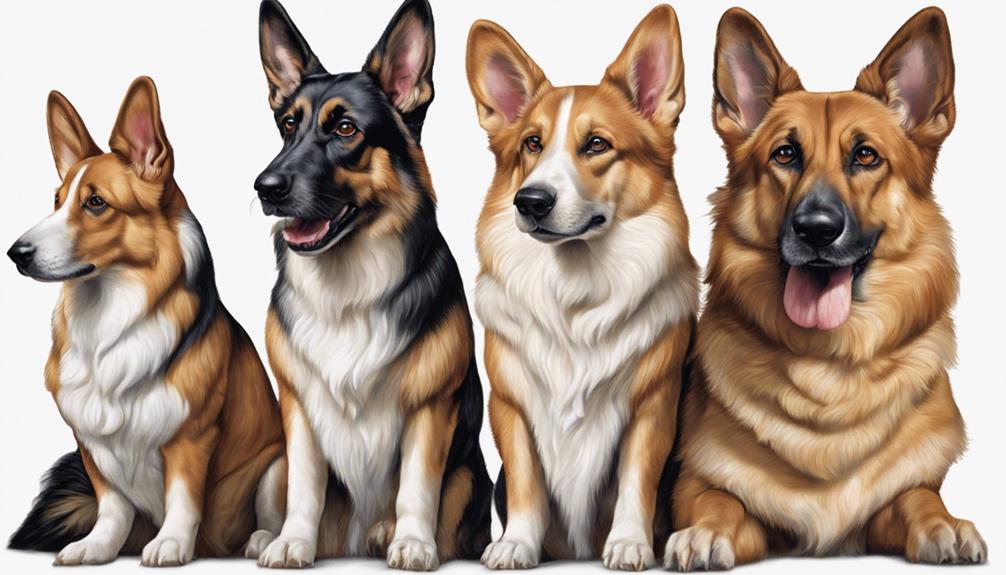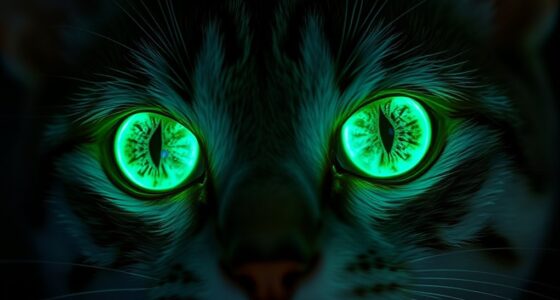When it comes to cats and peanuts, it's best to stay away from offering them this snack. Peanuts can lead to gastrointestinal upset and allergies in cats. The high fat content in peanuts might contribute to obesity and pose a choking hazard. Peanuts lack essential nutrients for cats. To guarantee your feline friend's well-being, opt for safer snack choices like meat, wet food, or commercial treats. These alternatives provide the necessary nutrients for your cat's health and happiness. Discover more about safe treats for your furry companion to keep them thriving with a balanced diet.
Key Takeaways
- Peanuts lack essential nutrients for cats' diets.
- Allergic reactions in cats can be severe.
- Peanut shells pose a choking hazard.
- High fat content in peanuts can lead to obesity.
- Feeding peanuts to cats is not recommended for their health.
Peanuts and Cats: A Risky Combination
When it comes to feeding peanuts to cats, caution should always be employed to mitigate potential risks. While peanuts aren't toxic to cats, they can still pose health concerns if not given in moderation. Cats may develop allergies to peanuts, leading to adverse reactions that could impact their well-being.
The tough outer shell of peanuts also presents a choking hazard for cats, making it essential to either remove the shell or opt for safer snack options altogether. Additionally, peanuts lack essential nutrients for cats and can contribute to obesity if consumed regularly, further emphasizing the need for caution when feeding peanuts to feline friends.
To prioritize your cat's health, it's advisable to choose commercial cat treats specifically formulated to meet their dietary requirements. By being mindful of what we feed our cats, we can guarantee their safety and well-being while still providing them with tasty treats.
Potential Dangers of Feeding Peanuts
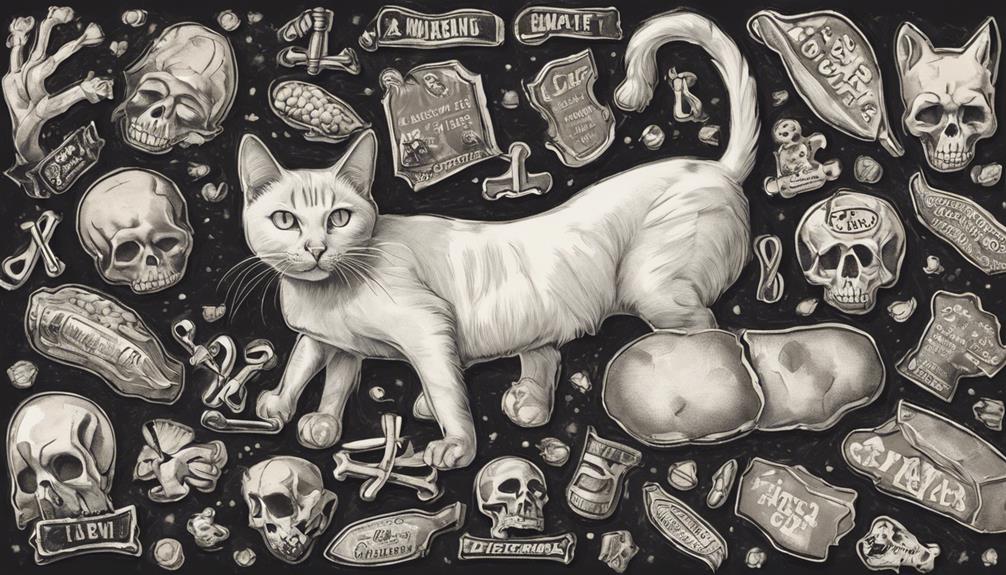
Feeding peanuts to cats can lead to gastrointestinal upset, including symptoms like diarrhea and vomiting.
Cats may develop allergies to peanuts, resulting in severe reactions such as difficulty breathing.
The high fat content in peanuts can contribute to obesity in cats if consumed regularly.
Allergic Reactions in Cats
Allergic reactions in cats to peanuts can pose serious health risks, including symptoms such as itching, skin rashes, and gastrointestinal upset. While peanuts aren't toxic to cats, the possibility of a peanut allergy shouldn't be underestimated.
In rare cases, cats can develop an allergy to peanuts, leading to more severe symptoms like difficulty breathing, swelling of the face or throat, and even anaphylaxis. It's important for cat owners to be vigilant and watch for any signs of allergic reactions after feeding their feline friends peanuts.
Choking Hazard Potential
Considering the potential dangers of feeding peanuts to cats, it's vital to be mindful of the choking hazard posed by the tough outer shells of peanuts. Cats may struggle to break down and digest these hard shells, which can lead to blockages in their digestive system.
Choking on peanut shells presents serious health risks for cats, including difficulty breathing and gastrointestinal issues. To prevent choking hazards, it's important to remove and discard peanut shells before offering them to your feline friend. Opting for unsalted, shelled, roasted peanuts is a safer choice for cats, reducing the risk of choking incidents.
Allergies and Digestive Issues in Cats
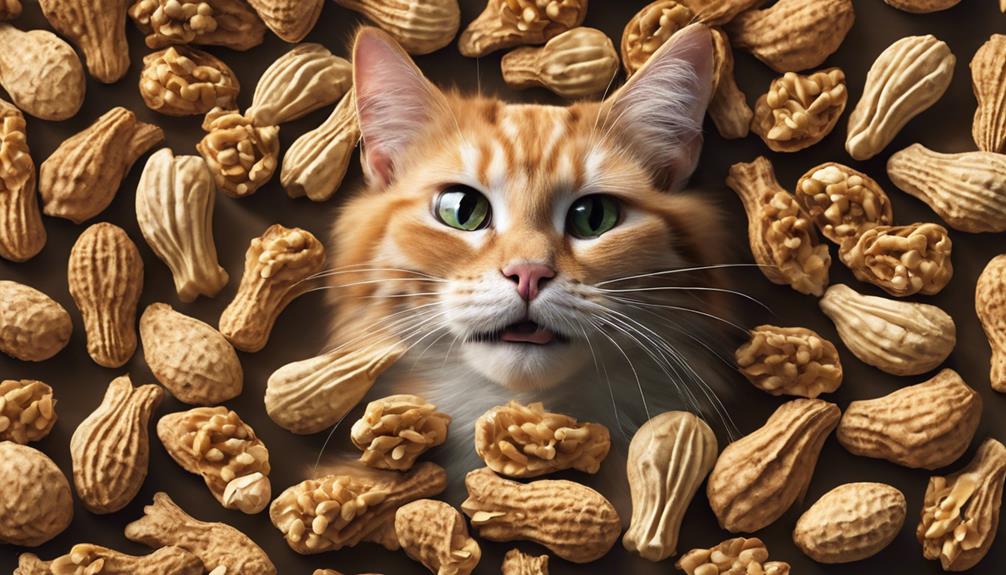
Cats can develop allergies to peanuts, resulting in symptoms like itching, rashes, and digestive issues. Peanut allergies in cats can be severe, sometimes leading to life-threatening situations that require immediate veterinary care.
It's important to be vigilant for any signs of allergies or digestive problems in cats when introducing peanuts into their diet.
Allergy Symptoms in Cats
When introducing peanuts into a feline's diet, monitoring for potential allergic reactions or digestive issues is important for their health and well-being. Cats can display allergy symptoms like itching, skin redness, and digestive problems such as vomiting or diarrhea if they're allergic to peanuts. In severe cases, peanut allergies in cats can lead to anaphylaxis, causing breathing difficulties and swelling.
It's essential to observe your cat closely for any signs of allergies after introducing peanuts. If you notice any unusual symptoms like itching, redness, or digestive upset, consulting a veterinarian is advised to guarantee your cat's safety and well-being. Being vigilant and proactive in monitoring your cat's response to new foods can help prevent serious health complications related to allergies.
Digestive Problems in Cats
After addressing allergy symptoms in cats related to peanuts, it's imperative to now focus on digestive problems that can arise in felines, including issues like diarrhea and vomiting. When cats eat peanuts, it can lead to various gastrointestinal concerns. Here are some key points to contemplate:
- Digestive Upset: Peanuts can cause gastrointestinal issues like diarrhea in cats.
- Vomiting: Cats may experience vomiting after consuming peanuts.
- Gas: Digestive problems from peanuts can result in cats having gas.
- Allergic Manifestations: Allergies to peanuts in cats can manifest as itching, swelling, and skin problems.
Managing Cat Sensitivities
With the potential for severe reactions like difficulty breathing, managing cat sensitivities to peanuts involves vigilant monitoring and prompt action.
Cats can develop allergies to peanuts, leading to symptoms such as vomiting, diarrhea, and other digestive issues. These sensitivities are often triggered by the proteins present in peanuts, causing discomfort for your pet.
If you notice any signs of allergies or digestive problems after introducing peanuts into your cat's diet, it's vital to consult with a veterinarian immediately.
Monitoring your cat closely for any adverse reactions to food is pivotal in ensuring their well-being. Remember, your pet's health should always be a top priority, so be proactive in managing their sensitivities to prevent any serious complications.
Obesity Risks From Peanut Consumption
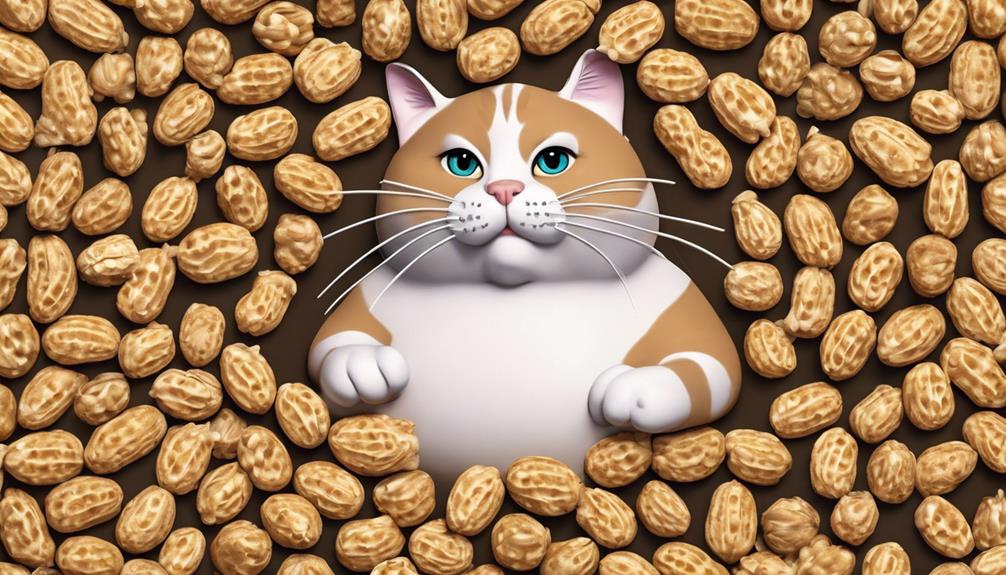
Peanut consumption poses a significant risk of obesity in cats due to its high fat content. Here are some essential points to keep in mind when offering peanuts to your feline friend:
- High Fat Content:
Peanuts are filled with fats that can quickly accumulate in your cat's diet, leading to weight gain and potential obesity.
- Weight Gain:
Regularly enjoying peanut treats can contribute to your cat putting on extra pounds, which may harm their overall health and quality of life.
- Occasional Treat:
While cats may enjoy the occasional peanut as a snack, moderation is key to prevent excessive calorie intake and subsequent weight issues.
- Monitoring Required:
Keeping a close eye on your cat's weight and body condition is important when incorporating peanuts into their diet to make sure they maintain a healthy weight and lifestyle.
Being mindful of the impact peanuts can have on your cat's weight is vital for their well-being. Moderation and observation are key to enjoying these treats without jeopardizing your cat's health.
Additives to Avoid in Peanut Products
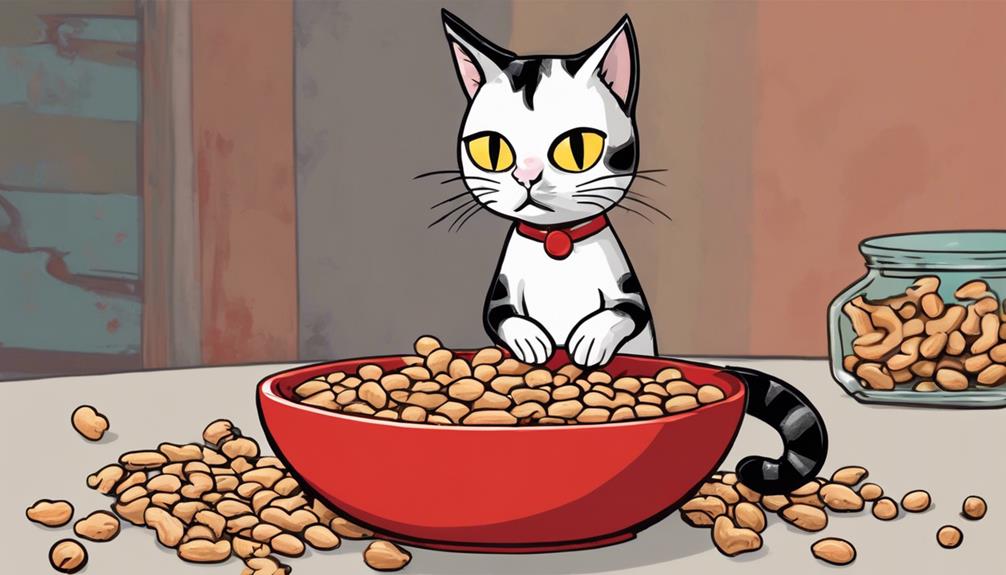
When choosing peanut products for cats, it is important to avoid additives like xylitol, chocolate, and sugary substances that can be harmful to their health. Xylitol is toxic to cats and can lead to severe health issues. Chocolate, another common additive, is also toxic to cats and should be avoided at all costs. Sugary additives found in some peanut products can cause inflammation, obesity, diabetes, and even cancer in cats. Checking product labels for harmful additives like artificial sweeteners, colors, and preservatives is crucial when selecting peanut products for your feline friend. Additionally, be cautious of high sodium levels in peanut products, especially if your cat has heart issues.
| Additives to Avoid | Potential Harm to Cats |
|---|---|
| Xylitol | Toxicity |
| Chocolate | Toxicity |
| Sugary Additives | Inflammation, Obesity, Diabetes, Cancer |
| High Sodium Levels | Impact on Cats with Heart Issues |
Moderation Is Key With Peanuts
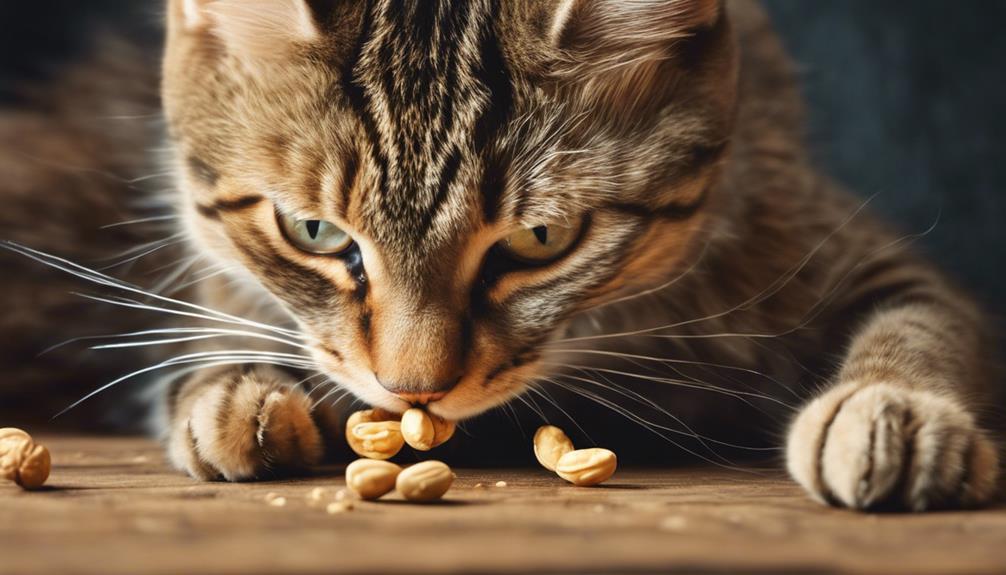
Occasionally indulging your feline friend with peanuts can be safe, but moderation is key to ensuring their well-being. When it comes to cats eating peanuts, remember these important points:
- Non-Toxicity: Peanuts are generally non-toxic to cats, making them a safe treat option when given in moderation.
- Small Doses: Limit the amount of peanuts you offer to your cat as they lack significant nutritional benefits for felines.
- Health Problems: Overfeeding peanuts can contribute to obesity in cats, potentially leading to health issues like diabetes.
- Avoiding Hazards: Always remove the shells from peanuts before offering them to your cat to prevent choking hazards.
While it's okay for your cat to snack on peanuts occasionally, keep in mind that they shouldn't be a staple in their diet. By offering peanuts in small amounts and ensuring your cat maintains a balanced diet, you can enjoy sharing this treat with your feline companion responsibly.
Nutritional Value for Felines

Understanding the dietary needs of cats is essential when considering the nutritional value of different food options. Cats are obligate carnivores, meaning their bodies require animal proteins to thrive. While peanuts are non-toxic to cats, they aren't recommended for feline consumption due to their plant-based protein content. Peanuts lack essential nutrients like taurine, which is crucial for a cat's health. Additionally, the fat content in peanuts may not align with a cat's dietary requirements.
Cats derive their nutritional needs from meat sources, and plant proteins like those found in peanuts don't provide the necessary nutrients for their well-being. Feeding cats a diet that includes peanuts could lead to deficiencies and health issues over time. Due to cats' natural carnivorous preferences, they may not find peanuts palatable. Hence, it's best to opt for cat-specific foods that are specially formulated to meet their unique dietary requirements and guarantee their health and well-being.
Cats and Peanut Butter: Compatibility Concerns

Peanuts, while not recommended for feline consumption due to their plant-based protein content, pose compatibility concerns for cats when it comes to peanut butter.
Here are some key points to think about when it comes to cats and peanut butter:
- Cat Eats: Though not harmful, cats should only consume peanut butter in small amounts.
- High in Fat: Peanut butter is high in fat, which can lead to obesity in cats if given excessively.
- Obesity Risk: Feeding cats peanut butter can contribute to feline obesity due to its high-fat content.
- Not Toxic: While peanut butter isn't toxic to cats, it isn't a necessary part of their diet and should be limited.
It's important to bear in mind that cats are obligate carnivores and may not find peanut butter appealing. Moderation is key to prevent gastrointestinal upset and weight issues. Think about offering healthier treats specifically formulated for feline nutrition to safeguard your cat's well-being.
Safe Alternatives to Peanut Snacks

Cats can enjoy a variety of safe alternatives to peanut snacks, including meat, wet food, and commercial cat treats. When considering your feline friend's diet, it's crucial to provide healthy options that cater to their nutritional needs. Here are some alternative treats that can be both delicious and beneficial for your cat:
| Treats | Description | Benefits |
|---|---|---|
| Meat | Lean proteins like chicken or turkey can be a hit | Essential for muscle health |
| Wet Food | Provides hydration and essential nutrients | Supports overall well-being |
| Commercial Treats | Specifically formulated for cats' dietary needs | Convenient and tasty |
Incorporating these options into your cat's diet can guarantee they receive the necessary nutrients without the risks associated with peanuts. Additionally, these alternatives offer healthy fats and proteins that are beneficial for your cat's health. By choosing safe and nutritious treats, you can spoil your cat while promoting their well-being. Remember, what's good for your cat can also have health benefits for humans, creating a win-win situation for everyone involved.
Ensuring Cat Dietary Needs Are Met
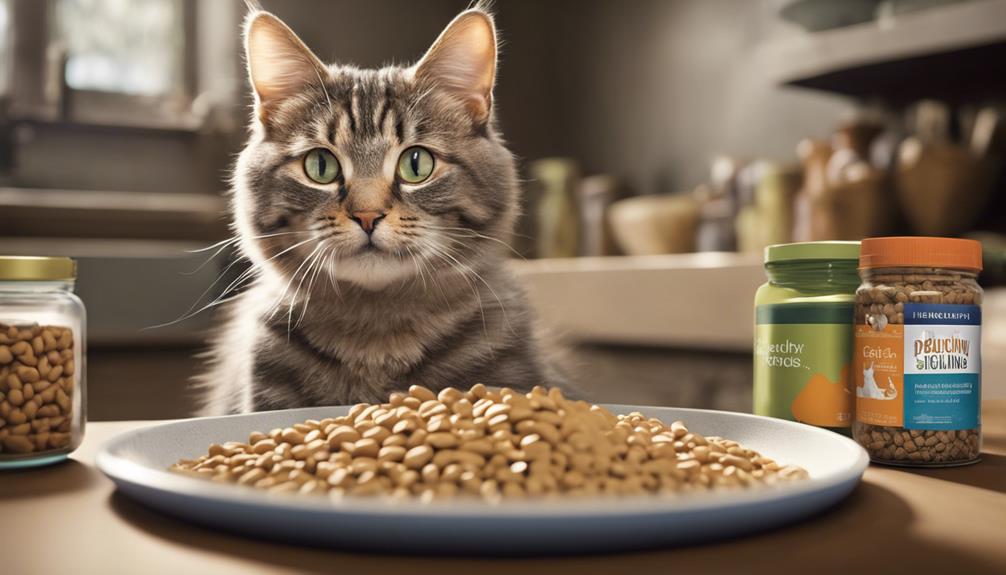
Let's talk about ensuring our feline friends get the nutrition they need.
Cats require a diet rich in animal protein to thrive, making balanced nutrition essential.
Cat Nutritional Requirements
Meeting the nutritional needs of cats is essential to guarantee their peak health and well-being. Here are some essential facts to keep in mind when ensuring your feline friend's diet meets their requirements:
- Cats need animal protein to thrive, as their feline digestive system can't efficiently digest plant-based proteins.
- Taurine, arachidonic acid, vitamins, and minerals found in meat-based diets are crucial for cats' overall health.
- Without properly formulated cat food, cats can develop serious health issues like heart disease and vision problems due to taurine deficiency.
- Commercial cat foods are tailored to meet the unique nutritional needs of cats, providing a balanced diet essential for their well-being.
It's crucial to make sure your cat's diet includes these key elements for their peak health and vitality.
Balanced Diet Importance
Prioritizing essential nutrients such as taurine, vitamins, and minerals is essential for maintaining a balanced diet that meets the dietary needs of cats for peak health. Cats thrive on diets rich in animal protein, making it crucial to choose the best food options for their well-being.
By feeding your feline friend a balanced diet, you guarantee they receive the necessary nutrients to support their overall health and energy levels. Whether you opt for commercial cat foods or prefer homemade options, it's critical to pay attention to the ingredients and nutritional content to guarantee your cat's diet is well-rounded.
Providing a balanced diet not only benefits your cat's physical health but also contributes to their overall happiness and longevity.
Potential Health Benefits
To guarantee that our cats' dietary needs are adequately met, it's important to prioritize providing them with foods rich in animal protein and essential nutrients. When considering potential health benefits for our feline friends, it's vital to be mindful of their unique digestive systems. Here are some key points to keep in mind:
- Cats are obligate carnivores, so they require animal protein for their best health.
- Peanuts lack vital nutrients necessary for a cat's diet.
- Regular consumption of peanuts can lead to obesity in cats due to their high fat content.
- Opting for healthier snack options like commercial cat treats helps make sure cats receive the necessary nutrients without the associated risks of spices, additives, and excessive fat.
Impact of Peanuts on Cat Health
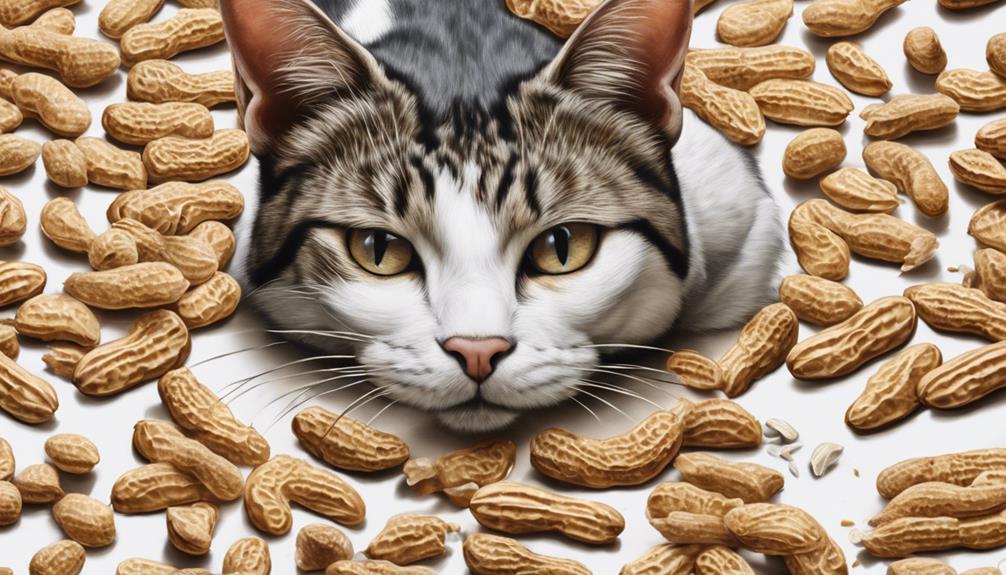
Peanuts have minimal positive impact on the health of cats due to their carnivorous dietary needs. While we may enjoy these crunchy treats, cats don't benefit from nuts like we do. In fact, regular consumption of peanuts can lead to various health issues for our feline friends. Digestive problems and allergies may arise, causing discomfort for our beloved pets. Additionally, the risk of obesity increases with frequent peanut consumption, potentially leading to more severe health conditions.
It's crucial to bear in mind that cats require animal protein for their best health, a nutrient that peanuts lack. Additionally, the hard shells of peanuts can be challenging for cats to digest, potentially causing gastrointestinal obstructions. To guarantee the well-being of our furry companions, it's best to stick to a diet that aligns with their carnivorous nature. While peanuts may be a tasty snack for us, they aren't suitable for our cat's delicate digestive systems.
Understanding Cats Digestive System

With a diet tailored to their carnivorous nature, cats possess a digestive system optimized for processing animal proteins efficiently. When understanding a cat's digestive system, it's important to take into account their unique biology as obligate carnivores. Here are some key points to keep in mind:
- Cats are designed to thrive on diets high in animal proteins, which provide essential nutrients for their overall health and well-being.
- Their digestive tract is short, reflecting their evolutionary need to quickly break down and absorb nutrients from meat-based sources.
- Plant-based foods, like peanuts, can be challenging for cats to digest due to their lack of specific enzymes for processing these materials.
- Selecting properly formulated cat food that's rich in animal proteins and high in calories is essential in meeting a feline's nutritional requirements and supporting their digestive health.
Understanding these aspects of a cat's digestive system is fundamental in ensuring they receive the appropriate diet for their carnivorous nature.
Adverse Effects of Excessive Peanut Intake

Monitoring your cat's peanut intake is crucial to prevent these adverse effects and safeguard their well-being.
Excessive peanut consumption in cats can result in various negative outcomes, such as the development of peanut allergies, digestive problems like vomiting and diarrhea, and worries about potential weight gain due to the high-fat content of peanuts.
Be sure to keep an eye on how many peanuts your cat consumes to avoid these issues.
Peanut Allergy Risks
Consuming excessive amounts of peanuts can pose significant risks to cats, potentially triggering severe allergic reactions with life-threatening consequences. When it comes to peanut allergy risks for cats, here are some important points to keep in mind:
- Allergy to Nuts: Cats can develop allergies to peanuts over time, leading to symptoms like skin irritation and gastrointestinal distress.
- Poisonous to Cats: Allergic reactions to peanuts in cats can be life-threatening, necessitating immediate veterinary care.
- Chronic Exposure: Continued exposure to peanuts can sensitize cats to allergens, heightening the risk of severe reactions.
- Monitoring Essential: Regularly monitoring your feline friend for signs of peanut allergies is essential to prevent adverse effects and maintain their well-being.
Digestive Issues Potential
When cats consume an abundance of peanuts, they may experience digestive issues such as diarrhea and vomiting. Cats' digestive systems aren't well-equipped to handle large amounts of peanuts due to their high fat content. This can lead to discomfort, gas, and potential stomach upset. While peanuts aren't toxic to cats, overconsumption can cause stomach disturbances and may even lead to an obstruction in extreme cases.
Providing your cat with a properly formulated diet is vital to prevent these issues. Roasted peanuts, in particular, can be harder for cats to digest, potentially causing indigestion and bloating. Keeping peanut intake within moderation is important to avoid gastrointestinal upset and maintain your cat's digestive health in balance.
Weight Gain Concerns
To prevent weight gain in cats, it's important to monitor their peanut intake carefully. Here are some key points to bear in mind:
- Excessive peanut consumption can lead to weight gain in cats due to the high fat content in peanuts.
- Weight gain in cats from consuming too many peanuts can increase the risk of obesity and related health issues.
- Cats should only be given peanuts in moderation to prevent unwanted weight gain.
- Monitoring the amount of peanuts given to cats is essential to maintain a healthy weight and prevent obesity.
Signs of Peanut Allergy in Cats
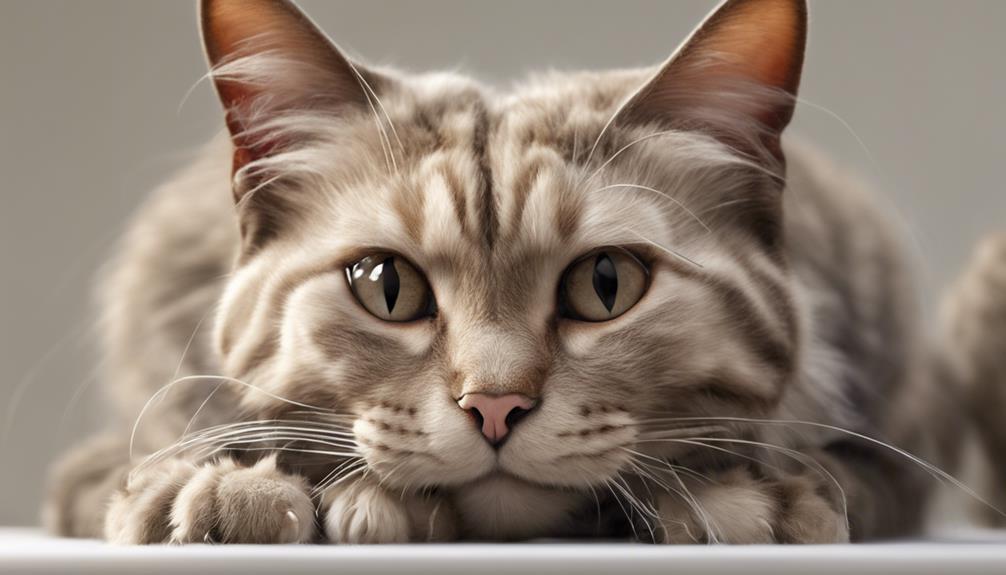
Peanut allergy in cats can manifest through various signs such as itching, swelling, redness, or hives on the skin. If your feline friend starts scratching excessively, pay attention – it could be a peanut allergy at play.
Keep an eye out for respiratory symptoms like coughing, wheezing, or difficulty breathing, as these could also indicate a reaction to peanuts. Digestive issues such as vomiting, diarrhea, or abdominal pain may suggest an intolerance to peanuts in cats.
Persistent itching, especially around the face, ears, or paws, might be a red flag for a peanut allergy. Remember, severe allergic reactions can lead to anaphylaxis, a serious and life-threatening condition that requires immediate veterinary care.
Conclusion: Best Snack Choices for Cats
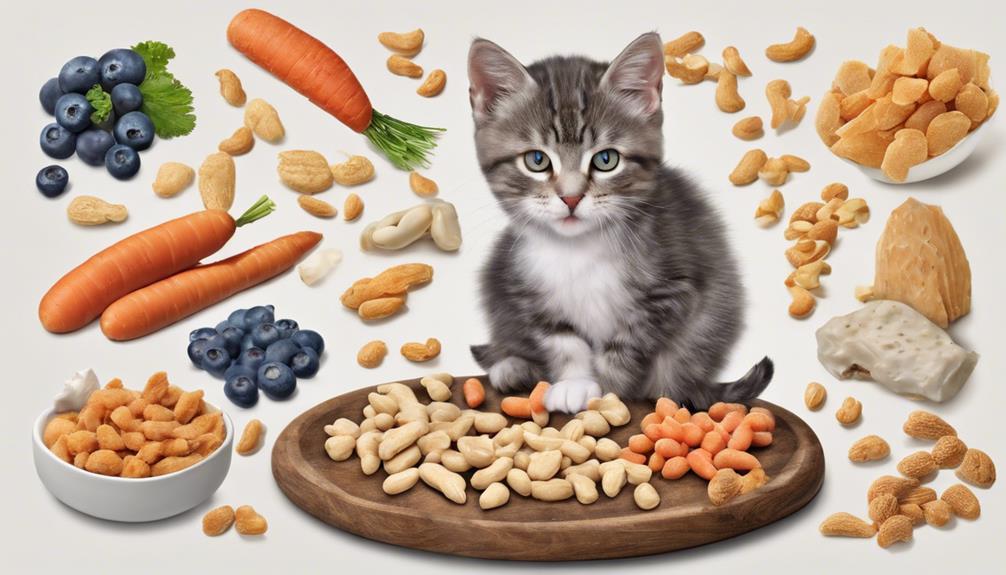
For the best feline health, prioritizing animal protein over peanuts in their diet is essential. When feeding your cat, consider these best snack choices to keep them healthy and happy:
- Cat Food: Opt for high-quality commercial cat treats or cat food specifically formulated to meet their nutritional needs.
- Lean Meat: Treat your cat to small amounts of lean meat like cooked chicken or turkey as a protein-rich snack.
- Wet Food: Incorporate wet food into your cat's diet as a tasty and hydrating snack option.
- Small Amount: Remember, moderation is key. Offer snacks in small amounts to prevent overeating and obesity.
Frequently Asked Questions
Is It OK for Cats to Eat Peanuts?
Yes, it's okay for cats to eat peanuts, but should be limited due to potential allergies and digestive issues. However, peanuts don't provide essential nutrition for cats. Choose cat treats designed for feline health instead.
Are Nuts Toxic to Cats?
Nuts aren't toxic to cats, but caution is key. Allergies can trigger severe reactions. Stick to raw, unsalted peanuts; avoid macadamia nuts. Shells are a choking hazard, so remove them. Treat sparingly for safe snacking.
Is Peanut Oil Toxic to Cats?
Peanut oil is generally safe for cats but may not suit their carnivorous taste preferences. It's high in fat, which can lead to weight gain if consumed excessively. Consulting a vet before adding it to a cat's diet is wise.
Is It Okay for Cats to Lick Peanut Butter?
Licking peanut butter can be a fun treat for cats, but it's crucial to monitor their intake. We enjoy watching our feline friends enjoy this snack, but remember, moderation is key to keeping them healthy and happy.
Is Tuckers Raw Dog Food Safe for Cats to Eat?
Conclusion
To sum up, while peanuts may seem like a tempting snack for your feline friend, it's best to steer clear of this risky combination. Potential dangers, from allergies to digestive issues, outweigh any potential benefits. Stick to cat-friendly treats to keep your furry companion happy and healthy.
Remember, when it comes to snacks for cats, it's better to be safe than sorry!

